Ijraset Journal For Research in Applied Science and Engineering Technology
- Home / Ijraset
- On This Page
- Abstract
- Introduction
- Conclusion
- References
- Copyright
The Dynamic Interplay of Tradition and Innova-tion: An Ethnographic Study of Bengaluru’s Urban Landscape
Authors: Ar. Monica Sharma, Ar. Piyush Pant
DOI Link: https://doi.org/10.22214/ijraset.2024.63903
Certificate: View Certificate
Abstract
The paper delves into the dynamic interplay of tradition and innovation in Bengaluru. Through ethnographic research and urban analysis, we explore how the city’s streets mirror its rich cultural heritage and technological progress. From Avenue Road\'s bustling markets to Malleswaram\'s serene lanes, Bengaluru\'s locations reveal a harmonious blend of customs and ad-vancements. These streets, hosting ancient temples beside skyscrapers and traditional eateries alongside fusion cuisine, are vi-brant stages of coexisting narratives. Furthermore, areas like Koramangala and Basavanagudi showcase the city’s entrepre-neurial spirit and artisanal preservation. Our findings highlight Bengaluru’s streets as catalysts of creativity and innovation, illustrating that tradition and modernity are complementary forces shaping the urban landscape. This research offers insights into Bengaluru’s evolving identity, presenting it as a nexus of cultural heritage and technological dynamism.
Introduction
I. INTRODUCTION
In the heart of Karnataka, where tradition dances hand in hand with progress, there lies a city that embodies the spirit of innovation and dynamism—Bengaluru (Hosteller, 2023). This bustling metropolis, often referred to as the 'Garden City' and the 'Silicon Valley of India,' is not merely a geographical location but an emotional tapestry woven with the threads of history, culture, and a relentless pursuit of excellence. Bengaluru, with its roots deeply embedded in the pages of time, unveils a captivating tapestry of tradition that weaves through the very fabric of the city. As one navigates the labyrinthine streets and tranquil corners of this metropolis, the echoes of bygone eras resonate, telling tales of a rich cultural heritage that has withstood the test of time. The city's historical icons, such as Tipu Sultan's Summer Palace and the Bull Temple, stand as silent witnesses to the passage of centuries, narrating stories of resilience and cultural amalgamation (HASAN, 1792).
The architectural grandeur of Bengaluru is punctuated by remnants of its storied past. Tipu Sultan's Summer Palace, with its intricately carved arches and vibrant murals, transports visitors to an era of opulence and artistic finesse. The Bull Temple, dedicated to Nandi, the sacred bull, is an awe-inspiring testament to the blend of Dravidian and Vijayanagara styles, creating an atmosphere of reverence that transcends time. The city's journey from Kempe Gowda's modest mud fort in the 16th century to the vibrant hub of today reflects not just the physical expansion but also the evolution of its spirit. Bengaluru, once a quiet village, burgeoned into a cultural hub rooted in Hindu traditions under Kempe Gowda's visionary leadership. Despite facing challenges and changes in cultural dominance over the centuries, Bengaluru has retained its unique identity, showcasing a harmonious blend of diverse influences (HASAN, 1792).
The colonial period saw Bengaluru transform from a strategic citadel into a British cantonment, setting the stage for the city's modern avatar. Neglected by the British, certain regions like Blackpally evolved into vibrant neighbourhoods, embodying the resilience and adaptability that define Bengaluru's character. The city's growth surged with the introduction of telegraph connections and rail connections, leading to the disappearance of city walls and unchecked expansion into the countryside. Post-independence, Bengaluru continued to thrive, becoming the capital of Karnataka in 1949. The city's relentless pursuit of progress marked the establishment of public sector industries, catapulting Bengaluru into a prominent science and technology hub.
The development of Electronic City in 1988 solidified its reputation as India's software capital, attracting a wave of young professionals and paving the way for the city's moniker as the 'Silicon Valley of India.' (Nagendra, 2016)
Religious diversity in Bengaluru is not just an architectural spectacle but a living testament to the city's inclusive ethos. Hindu temples like the Bull Temple and Gavi Gangadhareshwara Temple coexist harmoniously with intricately designed mosques like Jamia Masjid and churches like St. Mary's Basilica. This cultural kaleidoscope, etched in stone, invites everyone to appreciate and celebrate the unity within Bengaluru's religious diversity. Festivals paint the city in vibrant hues, showcasing Karnataka's dynamic art scene and cultural richness. Ugadi, the Kannada New Year, and Mysuru Dasara, spanning ten days, bring communities together in celebrations that go beyond rituals to embody the spirit of new beginnings and cultural unity. Traditional events like Kambala, rooted in rural traditions, serve as both sport and cherished tradition, connecting the present to the past.
The artistic heritage of Karnataka transcends the canvas, with Mysuru style paintings, tribal art forms like Hase Chitra mud painting, and the UNESCO World Heritage Site of Hampi, narrating stories of legends and historical significance. The state's linguistic diversity, reflected in languages like Kannada, Tulu, Konkani, Kodava, Urdu, and Beary, adds layers to Karnataka's cultural identity. Bengaluru's embrace of both Hindustani and Carnatic music reflects a cultural richness that has fostered exceptional talent and innovation. Renowned figures like Basavaraj Rajguru, Puttaraj Gawai, and Purandara Dasa have left an indelible mark, contributing to Karnataka's distinguished position in the world of Indian classical music (Aditi De, 2008).
In the culinary kaleidoscope of Bengaluru, traditional South Indian flavors harmonize with global influences, creating a gastronomic journey that mirrors the city's diversity. Iconic eateries serving masala dosa and experimental cafes exploring fusion cuisines epitomize Bengaluru's evolving palate. Amidst the concrete jungle, Bengaluru remains the 'Garden City,' with lush parks like Cubbon Park and Lalbagh Botanical Garden offering a tranquil respite. These green oases not only showcase the city's commitment to preserving nature but also provide spaces for residents to unwind and connect with their surroundings. The age-old markets of Bengaluru, like Chickpete and Malleswaram, resonate with the pulse of tradition, transporting visitors to a bygone era where commerce unfolded in narrow lanes lined with shops selling silk sarees, jewellery, and spices.
Cultural institutions like the Visvesvaraya Industrial and Technological Museum and the Karnataka Chitrakala Parishath stand as guardians of Bengaluru's cultural legacy. These institutions not only showcase the city's past but also bridge the gap between history and the present, fostering an appreciation for the evolving narrative of Bengaluru. The favourable climate of Bengaluru has played a pivotal role in esablishing it as a leading center for technology, electronics, and startups. This climate not only attracts talent but also fosters a culture of innovation, contributing significantly to the city's global recognition in the technology and entrepreneurship spheres.
The city's economic opportunities in IT, biotech, aerospace, and finance have fuelled a steady influx of people from various regions. This migration has enriched Bengaluru's multicultural fabric, creating a melting pot of diverse cultures, languages, and traditions. Despite rapid urbanization, Bengaluru remains committed to environmental sustainability. The city boasts expansive green spaces like Lalbagh and Cubbon Park, providing residents with much-needed recreational areas. Lake restoration and pollution control efforts underscore the city's dedication to preserving its natural heritage, aligning with global efforts to combat climate change.
Bengaluru's culinary landscape mirrors its cultural diversity. From traditional Kannada cuisine to international delicacies, the city caters to a myriad of tastes. The culinary scene becomes a reflection of the city's openness to different cultures and influences, creating a gastronomic tapestry that adds to Bengaluru's charm. The city's vibrant arts scene, characterized by festivals, exhibitions, and performances, celebrates Bengaluru's creative spirit. Diverse cultural festivals reflecting the multi-lingual community contribute to a rich cultural calendar, making the city a hub for artistic expression and cultural exchange.
Bengaluru's historical cantonment area preserves the city's longstanding military legacy. The blend of colonial architecture with modern urban development in this region serves as a testament to Bengaluru's ability to seamlessly integrate its historical roots with its ever-evolving present. Bengaluru's global recognition as a technology and innovation hub underscores its pivotal role in shaping the future. The city's status as the Silicon Valley of India is a testament to its contribution to technological advancements and entrepreneurial endeavours, making it a magnet for talent and investment (Tambour, 2014).
The development of infrastructure, including the expanding metro network, enhances Bengaluru's connectivity. Improved transportation facilitates the movement of people and goods, contributing to economic growth and positioning the city as a vital economic hub in India. Beyond its reputation in the IT sector, Bengaluru boasts economic diversity, with thriving industries in biotechnology, aerospace, and finance. This dynamic economic landscape positions Bengaluru as a key player in India's growth story, contributing to the country's economic development and progress (S.Srinivas, 1997).
However, amidst its achievements, Bengaluru grapples with several challenges. Traffic congestion, water scarcity, and the pressures of rapid urbanization pose significant issues that impact the city's infrastructure and overall quality of life. Addressing these challenges is crucial for Bengaluru to sustain its growth while ensuring a high quality of life for its residents. As we unravel the layers of Bengaluru's enigmatic charm, the city reveals itself not just as a geographical entity but as an emotion, a living history that invites all to explore and participate in its continuous evolution. Bengaluru's unofficial slogan, "Namma Bengaluru" (Our Bengaluru), captures the essence of belonging, resonating with every resident who feels connected to the dynamic spirit of this city. In the corridors of Bengaluru's history, every corner holds a secret, and every page turned reveals a new facet of its heartwarming story. Welcome to the city that thrives on contradictions, beckoning us to explore its depths incognito, and embrace its ever-unfolding narrative with open hearts and open minds (Undurti, 2017).
II. METHODOLOGY
The research employs a multi-faceted methodology to explore Bengaluru's unique identity, characterized by its blend of tradition and innovation. Beginning with a comprehensive literature review, the study synthesizes existing academic papers, books, and historical records to form a foundational understanding of Bengaluru's historical, cultural, and urban development. This is followed by a detailed historical analysis, which traces the city's evolution from its pre-colonial origins, through the colonial era, and into the post-independence and contemporary periods.
Field research is then conducted to gain first-hand insights, focusing on key streets such as Malleshwaram, Brigade Road, Gandhi Bazar, Koramangala, and VV Puram. During these visits, observational techniques, photographic documentation, and informal interviews with local residents and business owners are utilized to capture the unique characteristics of each street. Data collection involves both qualitative and quantitative methods, including surveys, structured interviews, demographic data, and economic indicators. The collected data is meticulously analyzed using qualitative coding, statistical methods, and Geographic Information System (GIS) tools to identify patterns and correlations.
The identification of key streets synthesizes insights from the historical analysis and field research, highlighting their contributions to Bengaluru's identity. Finally, the findings are synthesized to provide a cohesive narrative of how the city's traditions harmonize with its innovative spirit, culminating in a conclusion that offers recommendations for preserving Bengaluru's unique character amidst urbanization and economic growth. This methodology ensures a thorough and nuanced exploration of Bengaluru's multifaceted identity.

Figure 1 Flow Daigram of Research Methodology
III. THE VIBRANT STREETS OF BENGALURU
The research study examines five significant streets in Bengaluru—Malleshwaram, Brigade Road, Gandhi Bazar, Koramangala, and VV Puram—each symbolizing various facets of the city's identity. Through field visits, observational techniques, and interviews with local residents and business owners, the study captures the essence of each street, illustrating their collective contribution to Bengaluru's unique character.
A. Malleshwaram: A cultural Heritage
1) Historical Context And Significance
Malleshwaram, one of bengaluru’s oldest and most culturally rich neighborhoods, was developed as a planned suburb in the late 19th century. The area was established following the great plague of 1898, which led to the relocation and establishment of new residential zones to accommodate those affected by the epidemic (Bureau, 2022). Named after the kadu malleshwara temple, which dates back to 17th century, the area has retained its historical charm amidst the city’s rapid urbanization.
B. Community and lifestyle
Malleshwaram epitomizes a community-oriented lifestyle with a blend of traditional and morden elements. The neighborhood is characterized by its main roads, margosa road and sampige road, named for lush greenery lining these streets. Margosa road, for instance, is known for its neem (margosa) trees, providing a picturesque and serene environment (Bureau, 2022).
The locality uses a distinctive main and cross structure for its road layout, with “Mains” running parallel and “crosses” perpendicular to them. This setup not only facilitates easy navigation but also reinforces a sense of community among residents. Malleshwaram is renowned for its cultural heritage, housing several historical landmarks and temples, including the Kadu Malleshwara Temple. This temple is a focal point of spiritual and cultural activities, attracting numerous devotees, especially during festivals like Maha Shivaratri and Ugadi? (Nirvandiaries).
The area is also home to prestigious education institutes, contributing to its reputation as a hub for quality education. This blend of cultural and educational landmarks enhances the neighborhood’s appeal as an ideal residential area for middle- class families (Bureau, 2022).

Figure 2 Malleshwaram Street map, Bengaluru: Source: Openstreet map
C. The street
The busiest street in Malleswaram is 8th Cross, the main shopping hub for residents. This vibrant street offers everything from clothes, vegetables, and fruits to utensils and street food. Always bustling with activity, 8th Cross is the lifeline of Malleswaram. During festive seasons, the street becomes packed with people, leaving hardly an inch of space to move, yet this never deters shoppers. This is the peak time for vendors, who leave no stone unturned to attract customers. Prices of essential commodities often rise during this period, but people still purchase enthusiastically. The charm and joy of shopping here are incomparable to the sophistication and gloss of big malls, offering a truly unique experience.
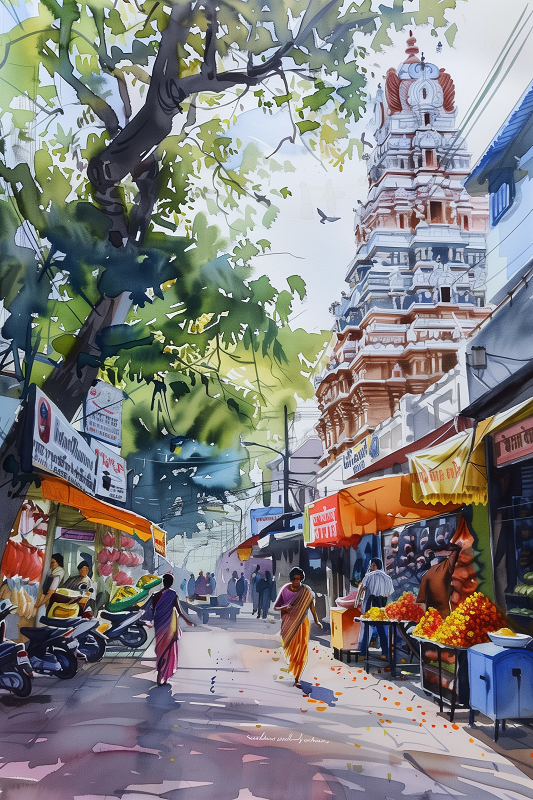
Figure 3 Watercolor painting of Malleshwaram Street, imagined by Author and created with AI Tool
Malleswaram is also home to several temples that reflect the religious sentiments of its residents. These include the Ganesha Temple near 8th Cross, Raghavendra Swamy Temple near 8th Cross, Sai Baba Temple on 15th Cross, Narasimha Swamy Temple on Temple Street, Kannika Parameswari Temple on 8th Cross, Kadu Malleshwara Temple (which gives Malleswaram its name), and Venugopala Swamy Temple on 11th Cross. Besides being a great place to relax, Malleswaram also has its share of daily life challenges.
When it comes to fast-food joints, Malleswaram is a hotspot. Popular eateries include CTR (Central Tiffin Room) or Shree Sagar, known for their dosas, Sahyadri, another great spot for dosas, and Janata Hotel on 8th Cross, which is also famous for dosas.
Additionally, the chat wala who parks his gaadi is a local favorite. Margosa and Sampige Roads, bustling thoroughfares in Malleswaram, are prime destinations for thousands of Bengalureans who flock here for shopping. However, the persistent lack of parking space has led to recurrent traffic congestion along these busy streets. With numerous business establishments attracting visitors from across Bengaluru and other parts of Karnataka, the footfall is significant. Unfortunately, vehicles parked along both sides of the road exacerbate the congestion, often forcing people to park in distant interior locations. This frequently results in unknown vehicles blocking gates, causing inconvenience. Additionally, parents dropping off their children face challenges in securing parking due to the absence of designated spaces provided by educational institutions. Consequently, people end up blocking footpaths with their cars, forcing pedestrians to walk on the main road.
D. Modern Developments and challenges
Despite its rich historical context, Malleshwaram has faced challenges due to urbanization and commercialization. The neighborhood has witnessed significant development, which, while bringing modern amenities, has also led to issues such as congestion and the encroachment of public spaces by vendors. Residents continue to strive to preserve the area’s traditional charm by planting trees and maintaining the cultural ethos (Bureau, 2022).
IV. THE CHARM OF BRIGADE ROAD
Brigade Road is a prominent commercial center and one of the busiest shopping areas in the heart of Bangalore, the capital of Karnataka, India. It is a one-way road connecting M G Road to Hosur Road, with intersections at Residency Road and Church Street. Historically, during the pre-independence era, Brigade Road was known as South Parade. This area has a rich history, though it is now characterized by modern buildings alongside some old structures that retain its historical essence.
In its earlier days, Brigade Road was not the commercial hub it is today but rather home to family-run establishments. It was named after a unit of the British Army, with the Madras Pioneer regiment stationed there during World War II. Brigade Road holds various other distinctions, including being the location of India's first KFC outlet, which opened in June 1995. Today, approximately 1,400 cars are parked on this road daily. The road was renamed Mahatma Gandhi Road on February 26, 1948, but it continues to be known by its historical name, South Parade, by some (Ram, 2017).
A. Brigade Road as Bangalore’s Central Business District
The central business district of Bangalore is the area within a 6 km radius around Vidhan Soudha. This is the center of the city and core commercial area of Bangalore which was founded by Kempe Gowda of the Vijayanagara Empire.
Most of the land is used by commercial establishments and the Indian Army with plans of skyscrapers under works. It has multiple high-rises including World Trade Center Bangalore and UB Tower. It also includes heritage properties like the Bangalore Fort and the Bangalore Pete. The Collection in UB City is one of the first luxury shopping malls of South India.
The land in CBD is expensive; Brigade Road and MG Road are amongst the most expensive in India. It also houses many other high streets including Commercial Street and Church Street as well as the Karnataka Film Chamber of Commerce. In 2017, redevelopment work began on Church Street at a cost of ?9 crore, which made it the first street in the city to be paved from granite cobblestones. The cobblestones were laid in a Kasuti pattern to reflect Karnataka's cultural heritage. In 2020, Church Street ran a pilot project called Clean Air Street during which the street was converted into a pedestrian zone with a complete ban on automobile traffic. CBD is a tourist attraction as there are parks, government offices, educational institutions, business houses and hotels, shopping destinations, stadiums, museums, temples, mosques, churches, art galleries and entertainment zones. (Ram, 2017)
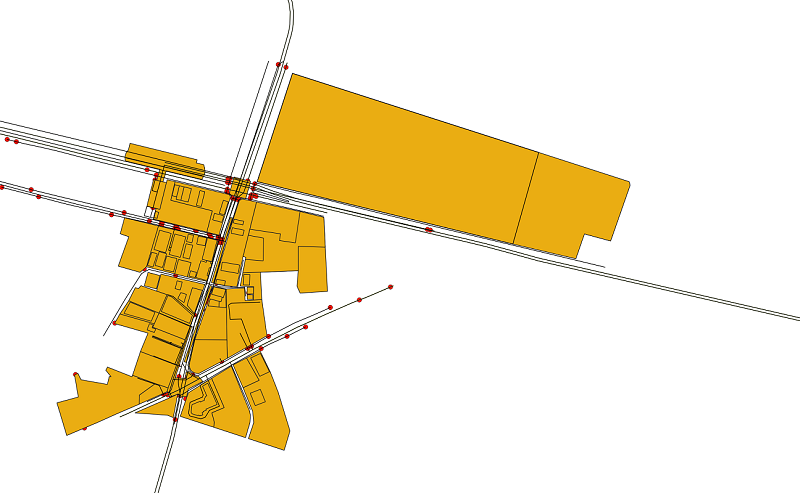
Figure 4 Brigade Road (in red) & MG Road (in blue) map , Bengaluru, Source: Open street map

Figure 5 Water color painting of Brigade Road, created with AI
B. Brigade Road’s Social Portrayal Style
The nightlife in Brigade Road and MG road is an inspiration for many to set up that kind of nightlife to attract the tourists and the people near those residential areas. In major boost to Chennai's night life, the Greater Chennai Corporation (GCC) is planning to revamp the Khader Nawaz Khan (KNK) Road into a pedestrian plaza where shops and pubs would stay open round the clock. The design of the plaza will be on the lines of Bengaluru’s popular Brigade Road and Mahatma Gandhi (MG) Road.
C. As a Mirror of Changing Society
Bengaluru grew from a small town to a big city. There has been a lot of development, there were many issues with the basic infrastructure before. But when we look forward now, there's been a lot of schools, colleges, hospitals, malls, clubs and a lot of companies. Which increases the density of its population. One of the most famous hubs for business and software companies, Bangalore has never failed to fulfill the needs of its people. Even though there's a lot of traffic due to the increase in density of its population people are equally benefited and with no doubt Bangalore has transformed many lives.
D. Inclusivity on wheels (food trucks and street hawkers)
Food Truck is fast becoming a trend in the city. These trucks are an easy way to get your hands on delicious food that is made right in front of your eyes.
No wonder various such trucks moving from one place to another, dishing out mouth-watering items like burgers, rolls, hotdogs, and sandwiches, have become a common sight in the city. Food became a love language and a means of empowerment in Bengaluru with the launch of Pride Cafe, a food truck, at WeWork Galaxy in Residency Road in an effort to provide employment and visibility to members of the LGBTQIA+ community. An initiative by the Solidarity Foundation in partnership with WeWork, Amadeus and Agape Hospitality Consultants, the cafe aims to offer breakfast, lunch and snacks to those working and passing by WeWork Galaxy. With a view that “The food truck will help people understand the idea of gender inclusivity and relate to those who feel they could not open up about their queer identity in the society.” This is one of the great examples to show the inclusivity among people.
V. GANDHI BAZAAR: A CULTURAL HAVEN
Basavanagudi is one of the oldest and historically significant areas of growing metropolitan city of Bangalore. It is named after a huge temple dedicated to bull (Basavanagudi) which is a major religious landmark on the cultural map of Bangalore. The two primary roads connecting this street is DVG road and KR road.
Gandhi bazaar was named after mahatma Gandhi as he marched from Lalbagh to national college. Basavanagudi, is one of the oldest and historically significant areas of growing metropolitan city of Bangalore. It is named after a huge temple dedicated to bull (Basavanagudi) which is a major religious landmark on the cultural map of Bangalore. Gandhi bazaar was named after mahatma Gandhi as he marched from Lalbagh to national college. The people, language, festivities and the cuisine are key aspects that render Gandhi Bazaar as a 'Melting pot of Culture'. Beyond commerce, Gandhi Bazaar fosters a sense of community. Festivals and cultural events are celebrated with enthusiasm, bringing together people from diverse backgrounds.
A. Gandhi Bazaar – A street you go to, not just through
Throughout the day, the street transforms where morning sees the market come alive with the buzz of shoppers and vendors setting up their stalls. As the day progresses, the tempo changes, with the hustle during festivals and cultural events when the bazaar becomes a riot of colors and celebrations. The informal vendors share this neighbourhood with formal shops as well.
The flower stalls are the most entrancing as the brightly colored flowers displayed in numerous ways, there are also clusters of garlands that hang on low-lying branches with vivid color and nice smell. Hawkers are found everywhere in Gandhi Bazaar. Various kinds of hawking activities are carried out mostly of Flowers, Fruits and Vegetables.
B. Public realm and street edge conditions
The area is well connected by different street hierarchies and public transportation facilities within walkable distance. The bus route is unidirectional along the Gandhi bazaar main road from Tagore circle to Ramakrishna ashram circle. The metro is also in the close proximity to the market, making it convenient for people of Bangalore to commute to the area. Gandhi bazaar being the famous historic destination for several activities, attracts of traffic both masses and vehicular.
The encroachment by the vendors makes it difficult for the pedestrians to walk on footpath. The pavements are narrow and not maintained properly.
Gandhi Bazaar serves as a focal point for communal gatherings and interactions. Its open streets and market squares create a vibrant atmosphere that encourages social connections. Gandhi Bazaar functions as an economic hub and a social space. It accommodates vendors, artisans, and entrepreneurs, providing opportunities for economic activities. The market's presence adds to the unique identity of Bangalore, giving it a distinctive charm and character.
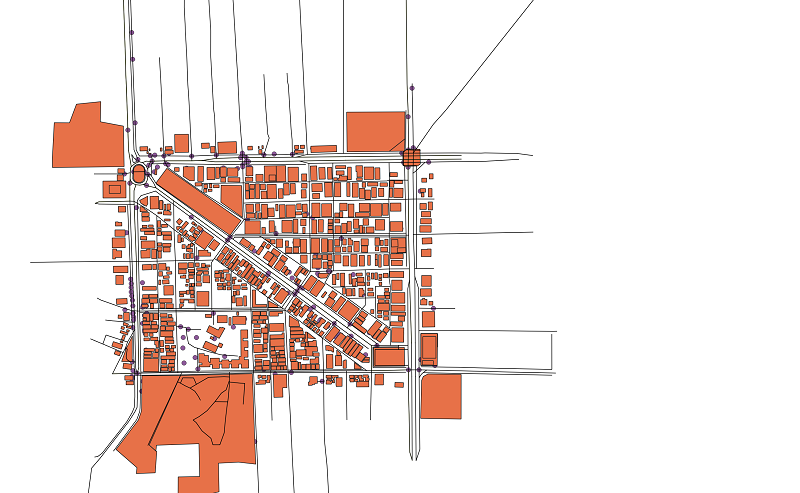
Figure 6 Gandhi Bazar(in green), Bengaluru, Source: Open street map
C. Colors of Gandhi Bazaar
Gandhi Bazaar has lively shopping interactions and is a place to be a part of. On any given day of the year, the Bazaar opens at six in the morning and closes at nine in the evening. The paths that take one towards the bazaar are territorialized by the informal sector, the paths within the market itself are patterns of human interaction
The vendor displays are simple creations that are changing and transforming themselves to attract and to sell better. The place is usually adorned with a variety of hues that reflect the Indian culture and the diversity of goods sold there
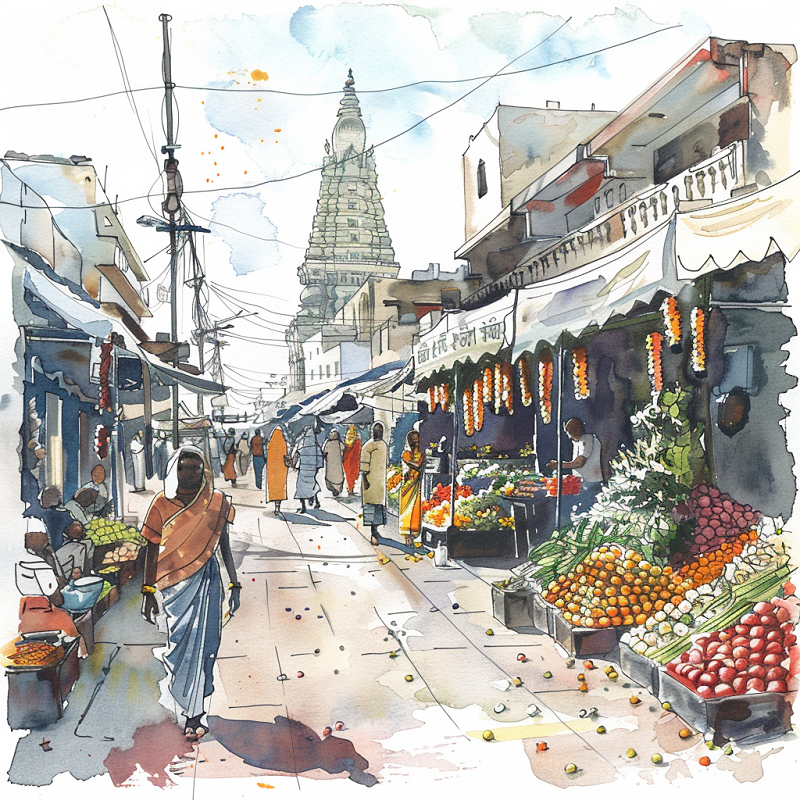
Figure 7 Water color Illustration of gandhi bazar, created with AI
D. Vidyarthi Bhavan: A Culinary Heritage of Bangalore:
Vidyarthi Bhavan stands as an iconic testament to the city's culinary heritage. Established in 1943, this legendary eatery has become a beloved institution, revered by locals and tourists alike for its delicious South Indian cuisine and timeless ambiance. Renowned for its masala dosas, crispy on the outside and bursting with flavors within, this iconic dish has been the star attraction for generations.
The idlis, vadas, and filter coffee are equally cooked to perfection using age-old recipes and ensuring that the flavors of the past remain intact.
E. A Shopper's Paradise:
The market's narrow streets are lined with an assortment of shops selling mix of goods. The vibrant silk sarees, jewels, and the aroma of fresh spices create an immersive experience for any visitor. The bazaar caters not just to the locals but also to tourists seeking authentic souvenirs and unique treasures. It is a treasure for collectors and antique enthusiasts. Vintage items, unique collectibles, and rare artifacts find their way into the market. It's a journey through history, artistry, and cultural heritage.
VI. THE NIGHT AT KORAMANGALA
As of my last knowledge update in January 2022, Koramangala is a vibrant and upscale neighbourhood located in the southeastern part of Bangalore, India. It is known for its cosmopolitan atmosphere, commercial significance, and diverse cultural landscape. Koramangala is a cosmopolitan neighbourhood in southeastern Bangalore, India. It's a popular area for young tech workers and students because of its many IT companies and colleges. Koramangala is known for its trendy stores, hip restaurants, and rooftop bars. It also has wide, leafy avenues, renowned malls, and community centres.
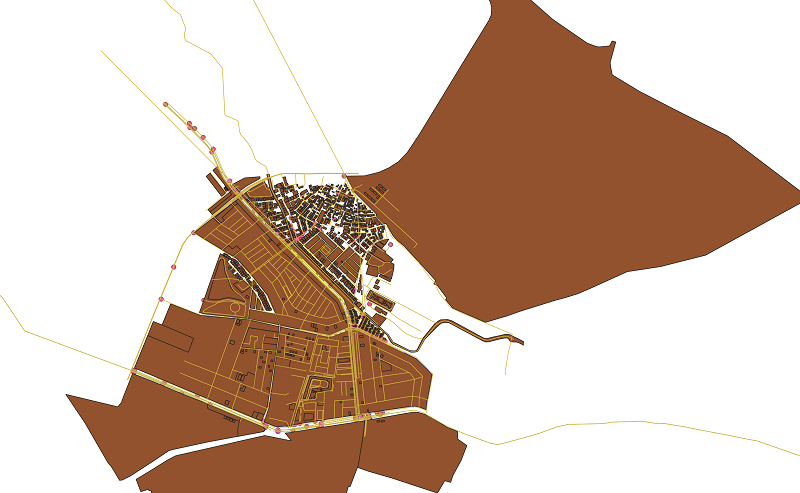
Figure 8 Koramangala, Bengaluru, Source: Open street map
A. Street of Koramangala:
The streets of Koramangala are characterised by a mix of residential, commercial, and recreational areas. The streets of Koramangala reflect the neighbourhood's diverse character, catering to the needs of residents, businesses, and visitors alike. The area is well-known for its tree-lined avenues, providing a relatively green and pleasant urban environment. Local markets, parks, and community spaces also contribute to the overall appeal of the streets in Koramangala. Keep in mind that urban developments can change, and it's advisable to check for the latest information or updates regarding the area.
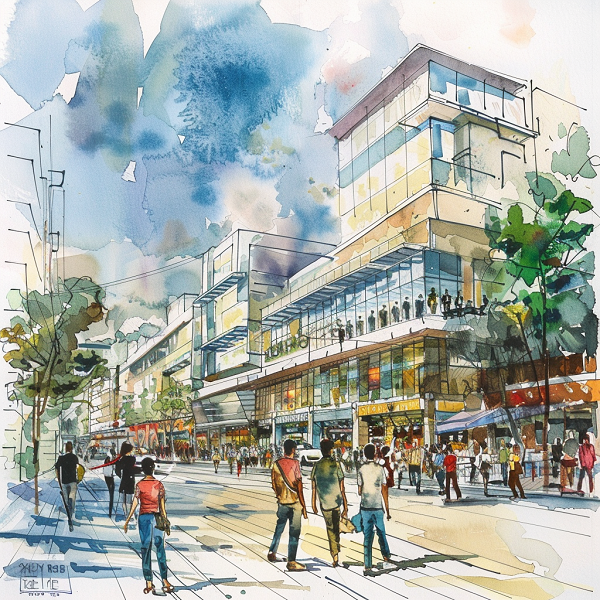
Figure 9 Water color illustration of Koramangala, generated with AI
B. Koramangala as A Start-Up Hub:
Koramangala is an amicable neighbourhood in Bangalore that has been getting a lot of attention lately. Start-up founders and businesses are taking an active interest in this place both nationally and internationally. This delightful place is referred to as the start-up hub of Bangalore. There are many companies who have their corporate offices in Koramangala and you could even spot the founder or co-founder of one of these big companies in popular cafes like Starbucks, Costa Coffee, Third Wave Coffee Roasters and Coffee Day.
C. Koramangala as Cosmopolitanism, Personified:
A residential and commercial hub that connects areas of vast growth in Bengaluru, Koramangala has become a great place to call home for a vast and diversified populace. People from all over India and the world, call it home. And with them has come food and living experiences that hail from all over. Within a single kilometer, one can start with filter kaapi, have butter chicken and naan, and finish off a satisfying meal with some world-class gelato. Whether you’re from Scandinavia or Lucknow, you’ll never be a fish out of water in Koramangala.
D. Go into the Night, and Find Life:
When you have some of the best eateries in town, it would stand to reason that Koramangala would have some epic places to hang out. After all, you’d need to break a sweat before you can dig in. From rooftop bars that show you incredible views to huge dance floors that lure you into the wondrous world of EDM, you’ll find your musical niche here. And from the most robust IPAs to the quirkiest of cocktails, there’s something for everybody’s palate somewhere in the eight blocks of Koramangala. So, go thee well into the good night.
E. The Food Is Too Great to Ignore:
Be it the recently concluded month of Ramadan where the street turned into a Khao Gully for a month or countless pubs and cafes to celebrate any occasion, Koramangala is a foodies’ paradise. From early morning breakfast joints to late-night food joints for your midnight munchies, the variety of food available here at any given time is mind-boggling.
VII. V.V.PURAM FOOD STREET
Nestled in the heart of the city, thindi beedi is a vibrant street lined with eateries serving a diverse variety of dishes. The food vendors here take immense pride in serving traditional South Indian delicacies, as well as popular street food items from various parts of India. It is also a haven for the vegetarian population as only vegetarian dishes are served here. This bustling street comes to life in the night hours, with vendors shouting, pans hissing and children laughing. The eateries stretch along a two hundred meter span of the street. The blinking shopfronts and tantalizing aromas add to the lively atmosphere of the street. Halfway through the street, is the Sri Raja Rajeshwari Temple. It provides a peaceful and spiritual respite amidst the bustling food street of VV Puram.
A. Evolution & Culture
The street which started as a “Pettige Angadi” or hole in the wall shop in the 60s has now grown into the bustling “Thindi Beedi”. It is surrounded by a residential area, which has a population predominantly comprised of the Vaishya, Brahmin and Jain communities.
The Vaishya community is an integral part of the V.V. Puram neighbourhood. They have resided in the neighborhood for decades and contribute to the cultural diversity and economic activities of the area. The Vaishyas are traditionally associated with trade, commerce, and business, and have been running the various eateries in the street.
They have played a significant role in sustaining the shops and ensuring that the primary functional nature of the street did not change. (as in commercial buildings with other purposes like clothing stores, jewellery shops, etc.) Over the years, VV Puram food street has witnessed significant growth and expansion. The number of food stalls and vendors has increased, offering an even wider variety of local delicacies and street food.
In the 2000s, there was an surge in activity due to the introduction of the Avarekalu Mela a yearly fair hosted by the shopkeepers, showcasing the versatile avarekalu (hyacinth beans).
It is a celebration of this local ingredient, which is widely used in traditional Kannada cuisine. During the Avarekalu Mela, the food street of V. V. Puram transforms into a hub of avarekalu-based dishes and delicacies. Visitors can indulge in a wide range of avarekalu-infused treats like avarekalu dosa, avarekalu vada, avarekalu usli, and more. Apart from the mouthwatering food, the Avarekalu Mela also features various cultural activities and performances, showcasing the rich heritage of Karnataka. Visitors can enjoy traditional music, dance, and folk performances, adding to the festive atmosphere. It is a celebration of the local cuisine and an initiative to support the local farmers of the state. It also introduced a new tradition to the citizens and cemented the street’s identity as the food street of V. V. Puram.
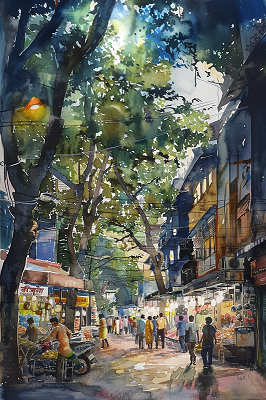
Figure 10 Water illustration of VV Puram street, generated with help of AI
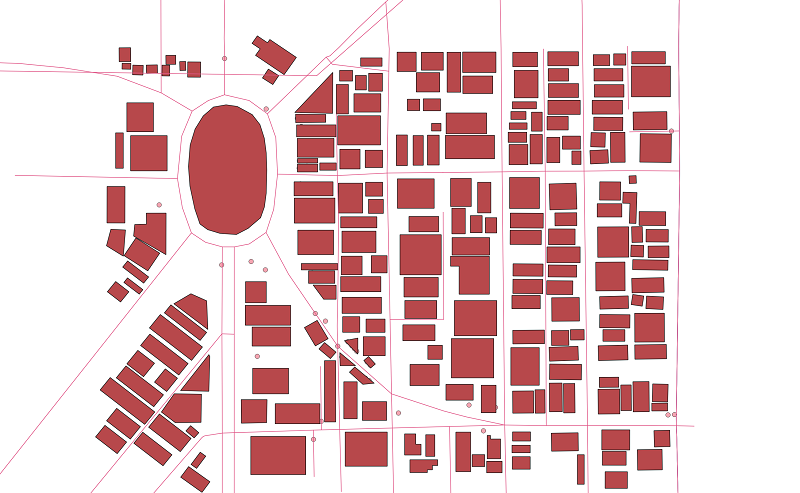
Figure 11 VV Puram food street map (in blue), Source: Open street map
However, the narrow street could not accommodate its rising popularity. Due to this BBMP proposed to renovate the street in 2022. Now the roads have been widened and vehicular entry to the streets have been restricted after 6pm.
B. Food & Culture
Another prevalent feature of this street is its herbivore nature. VV Puram serves only vegetarian food due to its strong influence from the local culture and traditions. Basavanagudi, the neighborhood where VV Puram is located, is known for its numerous temples. This and the temple at the centre of the street discourage the vendors from serving non-vegetarian food. The significant vegetarian population and a long-standing vegetarian culinary heritage of the city only contribute to this feature. Despite this dietary restriction, there is no compromise in the variety food being served. In fact, some may say it has pushed the vendors to be more creative in order to add the visitors’ culinary experience. Like the fire pan, it attracts throngs of customers who eagerly wait for the vendor to light the pan and carefully tuck it in their mouths. In conclusion, the street serves only vegetarian food owing to the cultural and religious demographics of its location.
Conclusion
A. Conclusion The research delves into the historical and cultural significance of various iconic streets and neighborhoods in Bangalore, exploring their evolution, contemporary challenges, and the unique charm they bring to the city. By examining areas like Malleshwaram, Brigade Road, Gandhi Bazaar, Koramangala, and V.V. Puram Food Street, the paper highlights the rich tapestry of Bangalore\'s urban landscape, reflecting its diverse heritage and modern-day dynamism. B. Findings 1) Historical Significance and Urbanization: • Malleshwaram, one of Bangalore\'s oldest neighborhoods, showcases a blend of historical charm and modern urbanization. Established in response to the 1898 plague, it retains cultural and historical landmarks amidst the city\'s rapid growth. • Brigade Road, once known as South Parade, has evolved from a residential area to a bustling commercial hub. Its transformation reflects Bangalore\'s broader urban development, blending historical structures with contemporary buildings. 2) Community and Lifestyle: • Malleshwaram epitomizes a community-oriented lifestyle, with its road layout fostering a strong sense of community. The neighborhood\'s blend of traditional and modern elements is evident in its cultural heritage and educational institutions. • Brigade Road serves as a central business district, highlighting the city\'s commercial vibrancy and social dynamics. Its role in shaping the nightlife and commercial culture of Bangalore is significant. 3) Cultural Heritage and Modern Challenges: • Gandhi Bazaar stands out as a cultural haven, reflecting Bangalore\'s rich heritage through its vibrant market life and historical significance. However, challenges like traffic congestion and the encroachment of public spaces by vendors pose ongoing issues. • Koramangala, a cosmopolitan neighborhood, illustrates the city\'s growth as a start-up hub and a melting pot of cultures. The area\'s nightlife and culinary scene further accentuate its modern, dynamic character. 4) Inclusivity and Community Spaces: • V.V. Puram Food Street, also known as Thindi Beedi, underscores the importance of community spaces in urban settings. The street\'s evolution from a small market to a bustling food hub reflects the city\'s adaptability and cultural inclusivity. • The introduction of initiatives like the Pride Cafe in Brigade Road highlights Bangalore\'s efforts towards gender inclusivity and social empowerment, showcasing the progressive ethos of the city\'s urban fabric. 5) Modern Developments and Cultural Preservation: • Across these neighborhoods, there is a consistent effort to balance modern developments with the preservation of cultural and historical heritage. Residents and local authorities strive to maintain the traditional charm of these areas amidst urbanization pressures. 6) Key Insights: • The research underscores the significance of historical and cultural landmarks in shaping the identity of Bangalore\'s neighborhoods. • Urbanization and commercialization bring both opportunities and challenges, necessitating a delicate balance between development and heritage preservation. • Community-oriented spaces and cultural inclusivity play a crucial role in fostering a vibrant urban environment. • Continued efforts are required to address challenges such as traffic congestion, public space encroachment, and the preservation of traditional lifestyles amidst modern developments. By examining the unique attributes and challenges of these iconic areas, the research provides a comprehensive understanding of Bangalore\'s evolving urban landscape, reflecting the city\'s rich heritage, dynamic growth, and the ongoing efforts to create a harmonious and inclusive urban environment.
References
[1] Aditi De. (2008). bengalore: Penguin Books. [2] Bureau, B. M. (2022, march 19). Bangalore mirror. Retrieved from Bangalore mirror: https://bangaloremirror.indiatimes.com/bangalore/others/mallesw aram-mirror-special-133-years-of-holding-heritage/articleshow/90312796.cms [3] HASAN, M. (1792). Bangalore through the centuries. Bangalore: Wesley Press, Mysore. [4] Hosteller, T. (2023, july monday). The History of Bangalore: Uncovering the City\'s Fascinating Past. Retrieved from thehosteller.com: https://www.thehosteller.com/blogs/the-history-of-bangalore-uncovering-the-citys-fascinating-past [5] Nagendra, H. (2016). Nature in the city. bengaluru: Oxford University Press. [6] Nirvandiaries. (n.d.). ND Communications - Travel & Lifestyle. Retrieved from ND Communications - Travel & Lifestyle: https://nirvandiaries.com/kadu -malleshwara-temple-malleswaram-bangalore/ [7] Ram, T. (2017, december 19). The news minute. Retrieved from The news minute: https://www.thenewsminute.com/karnataka/boxing-arenas -shopping- complexes-how-b-lurus-brigade-road-changed-over-years-73415 [8] S.Srinivas. (1997). URBAN DEVELOPMENT AND THE INFORMATION TECHNOLOGY INDUSTRY: A STUDY OF BANGALORE, INDIA. London: DEVELOPMENT PLANNING UNIT UTVERSITY COLLEGE LONDON. [9] Tambour, J. S. (2014). Weird Tales of a Bangalorean. bengalore: Dunhams Manor Press. [10] Undurti, J. (2017). Bangalore:A graphic novel: every city is a story. kindle.
Copyright
Copyright © 2024 Ar. Monica Sharma, Ar. Piyush Pant. This is an open access article distributed under the Creative Commons Attribution License, which permits unrestricted use, distribution, and reproduction in any medium, provided the original work is properly cited.

Download Paper
Paper Id : IJRASET63903
Publish Date : 2024-08-07
ISSN : 2321-9653
Publisher Name : IJRASET
DOI Link : Click Here
 Submit Paper Online
Submit Paper Online

